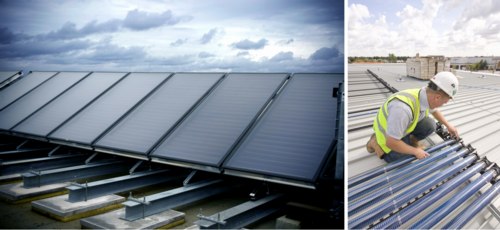Renewable energy on tap

Consultants and specifiers are increasingly specifying renewables to generate domestic hot water. Peter Gammon looks at how to get it right.
The combination of renewables and domestic hot water (DHW) can be a really good one. If specified and installed correctly, hot water generated from renewable sources not only reduces the building’s dependence on fossil fuels but also allows storage of energy and can provide the optimum operational load and running time conditions that these types of heat generator require.
Solar thermal is very often the first choice for integration into a building’s heating system to provide DHW. There are plenty of statistics out there, but I would suggest that a well designed solar thermal system can provide up to half of the DHW needs of a building. It is also a relatively cost-effective way to include renewables and, depending what the Government might do with the Renewable Heat Incentive, may well be even more so over the coming years.
Solar thermal works particularly well in buildings with a reasonably high and regular demand for hot water — such as busy households through to hotels, gymnasiums, schools with community use of the sports facilities etc. This is because, with solar thermal, any heat generated needs to be used or stored. In a hotel, for example, there is a big demand for hot water from the guests’ bathrooms and showers through to the kitchens and restaurants. In addition, such buildings are occupied every day of the year, so the demand is reasonably steady.
Given seasonal and diurnal variations in solar irradiation, a hot-water system using solar thermal energy must be able to perform to the needs of the building without any solar input.
The solar side of the system is in essence an add-on which assists the basic system whenever possible. The add-on items are the solar collectors and associated pipes, controls and pumps etc. and a dedicated amount of storage volume within the hot-water storage vessel that is exclusively for the acceptance of the heat energy collected from the solar collectors. Any energy exchanged into the dedicated solar volume is used to substitute primary energy when reheating the primary volume of the system. The capacity of a solar-supported hot-water storage vessel is increased according to the area of the solar collectors and must be taken into account when planning the installation space requirement.
The fundamental piece of information that is needed when planning for a solar-thermal hot-water system is the typical daily usage of the building for hot water — then you can work out how many solar collectors you need and what storage capacity.
The next step is to understand what target for the provision of renewable energy you are looking to reach. If you need got to get to a specific level in SAP calculations or if you are aiming for a particular BREEAM rating, you can set the percentage of renewables you need. All these calculations can be carried out with your supplier and manufacturer; here at MHS Boilers we have knowledgeable technical staff who can give guidance in the selection of equipment.

So how might all this look in practice?
We were recently involved with a 110-bedroom extension to a hotel. The solar element of the project included 70 m² of Elco Solatron R2.5 flat panel collectors. The solar collector field was split into four groups of seven solar panels, with each group connected to the lower coil in a specially fabricated and suitably sized solar twin-coil cylinder, with all the cylinders working in parallel to serve the hotel’s hot-water system. The upper primary coils in the cylinders are heated in a conventional way, with input from the hotel’s heating system served by four new MHS 540 kW gas-fired condensing boilers. The system is working very successfully and is fully able to cope with the hotel’s demand for hot water.
Solar thermal also works well in support of heat pumps for the generation of DHW and also helps improve BREEAM and SAP ratings.
Finally, consider biomass. Biomass boilers work well for the volume production of DHW as the demand can provide a desirable steady base load. You would typically select biomass boilers in the same way as condensing boilers — but not forgetting the normal requirement for a primary buffer vessel to smooth out peaks and troughs, as the response times of a biomass boiler is slower than a gas- or oil-fired boiler.
As the Renewable Heat Incentive takes hold, the integration of renewables and DHW systems will continue to challenge specifiers and consultants. We believe that is a good thing and are happy to meet that challenge head on.
Peter Gammon is technical product manager at MHS Boilers.








